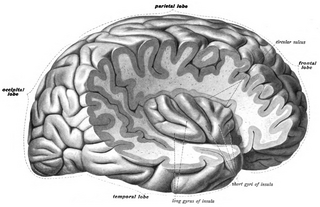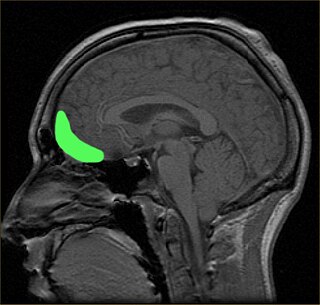
The auditory system is the sensory system for the sense of hearing. It includes both the sensory organs and the auditory parts of the sensory system.
In physiology, tonotopy is the spatial arrangement of where sounds of different frequency are processed in the brain. Tones close to each other in terms of frequency are represented in topologically neighbouring regions in the brain. Tonotopic maps are a particular case of topographic organization, similar to retinotopy in the visual system.

The insular cortex is a portion of the cerebral cortex folded deep within the lateral sulcus within each hemisphere of the mammalian brain.

Language processing refers to the way humans use words to communicate ideas and feelings, and how such communications are processed and understood. Language processing is considered to be a uniquely human ability that is not produced with the same grammatical understanding or systematicity in even human's closest primate relatives.
Neuroplasticity, also known as neural plasticity, or brain plasticity, is the ability of neural networks in the brain to change through growth and reorganization. It is when the brain is rewired to function in some way that differs from how it previously functioned. These changes range from individual neuron pathways making new connections, to systematic adjustments like cortical remapping. Examples of neuroplasticity include circuit and network changes that result from learning a new ability, environmental influences, practice, and psychological stress.
In animals, including humans, the startle response is a largely unconscious defensive response to sudden or threatening stimuli, such as sudden noise or sharp movement, and is associated with negative affect. Usually the onset of the startle response is a startle reflex reaction. The startle reflex is a brainstem reflectory reaction (reflex) that serves to protect vulnerable parts, such as the back of the neck and the eyes (eyeblink) and facilitates escape from sudden stimuli. It is found across many different species, throughout all stages of life. A variety of responses may occur depending on the affected individual's emotional state, body posture, preparation for execution of a motor task, or other activities. The startle response is implicated in the formation of specific phobias.

The orbitofrontal cortex (OFC) is a prefrontal cortex region in the frontal lobes of the brain which is involved in the cognitive process of decision-making. In non-human primates it consists of the association cortex areas Brodmann area 11, 12 and 13; in humans it consists of Brodmann area 10, 11 and 47.
The mismatch negativity (MMN) or mismatch field (MMF) is a component of the event-related potential (ERP) to an odd stimulus in a sequence of stimuli. It arises from electrical activity in the brain and is studied within the field of cognitive neuroscience and psychology. It can occur in any sensory system, but has most frequently been studied for hearing and for vision, in which case it is abbreviated to vMMN. The (v)MMN occurs after an infrequent change in a repetitive sequence of stimuli For example, a rare deviant (d) stimulus can be interspersed among a series of frequent standard (s) stimuli. In hearing, a deviant sound can differ from the standards in one or more perceptual features such as pitch, duration, loudness, or location. The MMN can be elicited regardless of whether someone is paying attention to the sequence. During auditory sequences, a person can be reading or watching a silent subtitled movie, yet still show a clear MMN. In the case of visual stimuli, the MMN occurs after an infrequent change in a repetitive sequence of images.

The ventromedial prefrontal cortex (vmPFC) is a part of the prefrontal cortex in the mammalian brain. The ventral medial prefrontal is located in the frontal lobe at the bottom of the cerebral hemispheres and is implicated in the processing of risk and fear, as it is critical in the regulation of amygdala activity in humans. It also plays a role in the inhibition of emotional responses, and in the process of decision-making and self-control. It is also involved in the cognitive evaluation of morality.

Catherine Dulac is a French-American biologist. She is the Higgins Professor in Molecular and Cellular Biology at Harvard University, where she served as department chair from 2007 to 2013. She is also an investigator at the Howard Hughes Medical Institute. She was born in 1963 in France. She came to the United States for her postdoctoral study in 1991.
Integrative neuroscience is the study of neuroscience that works to unify functional organization data to better understand complex structures and behaviors. The relationship between structure and function, and how the regions and functions connect to each other. Different parts of the brain carrying out different tasks, interconnecting to come together allowing complex behavior. Integrative neuroscience works to fill gaps in knowledge that can largely be accomplished with data sharing, to create understanding of systems, currently being applied to simulation neuroscience: Computer Modeling of the brain that integrates functional groups together.

Otto Detlev Creutzfeldt was a German physiologist and neurologist. He was the son of Hans Gerhard Creutzfeldt and the younger brother of Werner Creutzfeldt, a professor of internal medicine.
The oddball paradigm is an experimental design used within psychology research. Presentations of sequences of repetitive stimuli are infrequently interrupted by a deviant stimulus. The reaction of the participant to this "oddball" stimulus is recorded.

Angela Friederici is a director at the Max Planck Institute for Human Cognitive and Brain Sciences in Leipzig, Germany, and is an internationally recognized expert in neuropsychology and linguistics. She is the author of over 400 academic articles and book chapters, and has edited 15 books on linguistics, neuroscience, language and psychology.
Auditory fatigue is defined as a temporary loss of hearing after exposure to sound. This results in a temporary shift of the auditory threshold known as a temporary threshold shift (TTS). The damage can become permanent if sufficient recovery time is not allowed before continued sound exposure. When the hearing loss is rooted from a traumatic occurrence, it may be classified as noise-induced hearing loss, or NIHL.
Thomas S. Kilduff is an American neuroscientist and the director of SRI International's Center for Neuroscience. He specializes in neurobiology related to sleep and wakefulness, and was involved in the discovery of hypocretin, a neuropeptide system that is highly involved in wakefulness regulation.
Christopher A. Walsh is the Bullard Professor of Neurology at Harvard Medical School, Chief of the Division of Genetics at Children's Hospital Boston, Investigator of the Howard Hughes Medical Institute, and the former Director of the Harvard-MIT MD-PhD Program. His research focuses on genetics of human cortical development and somatic mutations contributions to human brain diseases.
Anna Wang Roe is an American neuroscientist, the director of the Interdisciplinary Institute of Neuroscience and Technology (ZIINT), and full-time professor at the Zhejiang University, Hangzhou, China. She is known for her studies on the functional organization and connectivity of cerebral cortex and for bringing interdisciplinary approaches to address questions in systems neuroscience.
Jan Born is a neuroscientist who researches the role of sleep in memory consolidation, problem solving, and brain plasticity. He is Head of the Institute of Medical Psychology and the Behavioral Neurobiology department at the University of Tübingen.

Susana Q. Lima is a Portuguese neuroscientist and principal investigator at the Champalimaud Centre for the Unknown in Lisbon, Portugal. Her research studies neural mechanisms of sexual behavior and mate choice.










